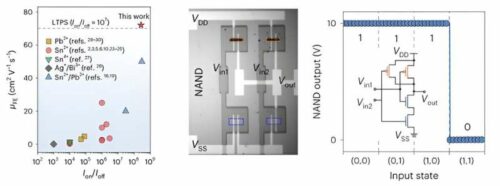Revolutionizing transistor design with cost-effective tin perovskite achieves unparalleled performance, promising affordable, eco-friendly electronics and game-changing integrated circuits for tomorrow.

Metal halide perovskites are semiconductors with superior optoelectronic characteristics, minimal imperfections, and budget-friendly manufacturing expenses. Unlike burgeoning semiconductors, these substances can be readily fabricated through cost-effective solution processing techniques.
Researchers at Pohang University of Science and Technology in South Korea, the Chinese Academy of Sciences and the University of Electronic Science and Technology of China have introduced a new approach to creating transistors utilizing metal halide perovskites, with a particular focus on tin perovskite.
A primary goal of the team was to develop a novel method for fabricating high-performance p-channel transistors utilizing economical halide perovskites. Transistors, ubiquitous switching devices, regulate the quantity of electrical current circulating within electronic components. The researchers fabricated new transistors using sheets of pure tin-based perovskite. Remarkably, these sheets are both cost-effective and readily available, potentially playing a significant role in drastically lowering the production costs of transistors. Besides being economical, the pure tin-based perovskite utilized by the researchers is environmentally benign. For successful integration into electronics, their crystallization must be precisely controlled, enabling the creation of high-quality, uniform films.
In initial tests, the transistors fabricated by the team demonstrated exceptional performance, showcasing hole mobilities exceeding 70 cm² and on/off current ratios surpassing 10⁸. Notably, their functioning mirrors the low-temperature polysilicon-based transistors in today’s market. The researchers expressed their belief that tin perovskite’s intrinsic high-hole mobility positions it as a prime candidate for transistor applications. They introduced a new A-cation design strategy that has enabled the pinnacle of performance witnessed in any transistor utilizing metal halide perovskites thus far. The efficiency of the new transistors aligns well with the polysilicon transistors currently employed in OLED driving circuits. The team anticipate that their approach will spur innovative designs for perovskite channels in the pursuit of high-performance transistor applications.
In the future, the methods pioneered by the team could lead to the first perovskite-based integrated circuits. Their research may steer the development of new, affordable electronic components compatible with existing CMOS technology, including OLED driving circuits.
Reference: Huihui Zhu et al, Tin perovskite transistors and complementary circuits based on A-site cation engineering, Nature Electronics (2023). DOI: 10.1038/s41928-023-01019-6






